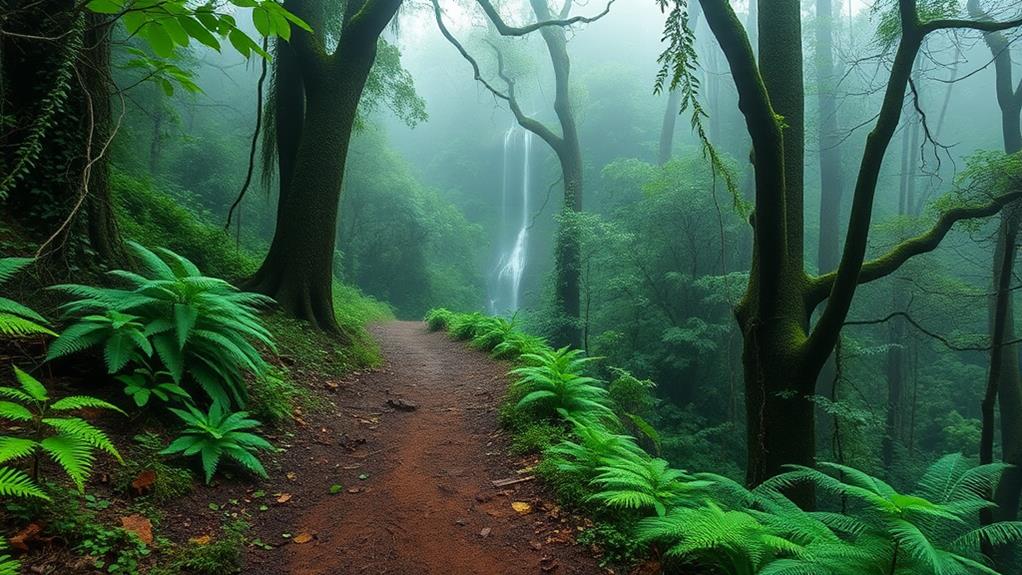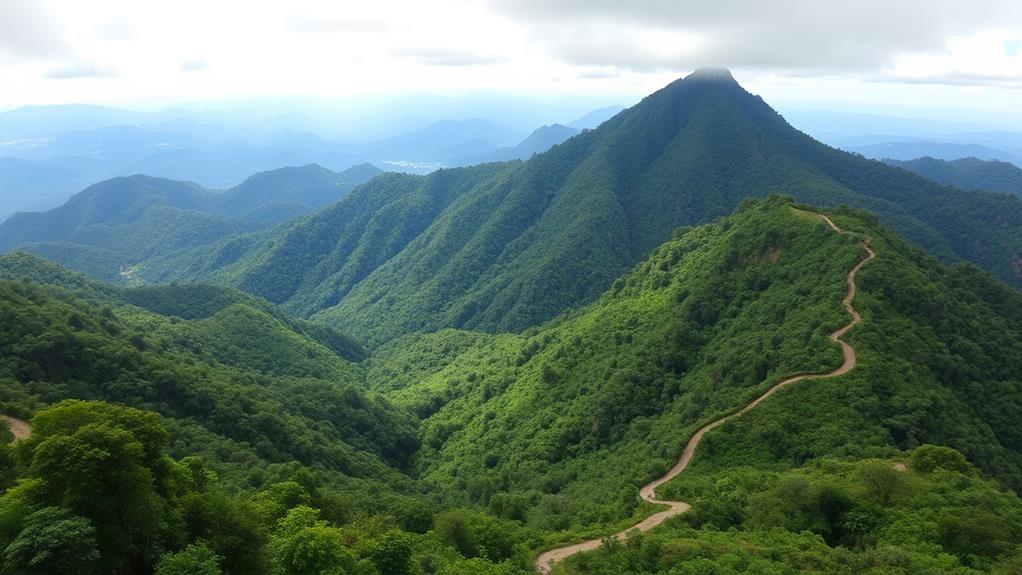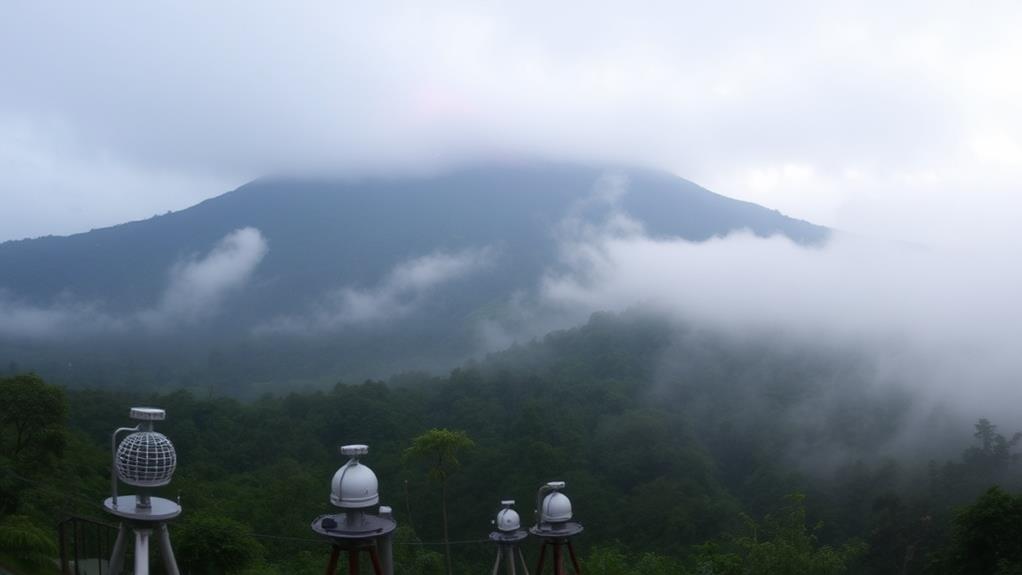Mount Isarog National Park spans 10,112 hectares in Camarines Sur, Philippines. This protected area is home to a diverse range of unique flora and fauna.
Five main trails, ranging from 1.8 to 7.7 miles, cater to various skill levels and outdoor enthusiasts. For instance, hikers can choose from trails that suit their abilities, from easy to challenging.
The park is a birdwatcher's paradise, with at least 143 bird species, including 15 endemic to Luzon. Some of these species include the Philippine cockatoo, Luzon bleeding-heart, and whiskered pitta.
Over 1,300 plant species thrive in the park. Examples of these species include the critically endangered Pinus insularis and the vulnerable Alstonia scholaris.
The park's biodiversity is complemented by its cultural significance. The Isarog Agta people have lived in the area for thousands of years, making it an important cultural heritage site.
Their presence has contributed to the park's rich cultural tapestry.
Discovering Mount Isarog's Trails

Mount Isarog National Park's trail system offers five main hiking trails that cater to varying skill levels and interests.
The longest trail is the Mount Isarog via Sulat Resort trail, stretching 7.7 miles with a significant elevation gain of 5,232 feet. In contrast, the Isarog Climb Trail provides a well-maintained 6.2-mile route to the summit, making it a popular choice among hikers.
For shorter hikes, the Villaflorida – Del Rosario Trail offers scenic views over 3.9 miles and is rated 5.0 stars by visitors. Waterfall enthusiasts will enjoy the Malabsay Falls trail, a 1.8-mile moderate hike leading to crystal-clear waters.
Regardless of your preference, each trail in Mount Isarog National Park caters to varying skill levels, providing family-friendly options and opportunities for biking and running on specific paths.
As you hike, you'll be surrounded by the park's rich flora and fauna, including endemic species. Take in the scenic views and immerse yourself in the natural beauty of Mount Isarog National Park. For those looking for a more adventurous experience, a challenging climb to the summit of Mount Isarog is a popular activity within the park. The lush greenery and diverse wildlife make the hike to the top a truly rewarding experience. Be sure to bring plenty of water and pace yourself as you make your way to the peak.
Biodiversity and Conservation Efforts
Mount Isarog National Park's diverse habitats support a wide range of biodiversity. The park is home to at least 143 bird species, with 15 of them endemic to Luzon, including the Velvet-fronted Nuthatch.
The park's habitats, including lowland forest, montane forest, and mossy forest, support around 1,300 known plant species. Many of these plant species are unique to the region.
Conservation efforts are crucial to preserve the park's biodiversity. The Mount Isarog Integrated Conservation and Development Project aims to promote sustainability while engaging local communities.
The park is home to unique and threatened wildlife, such as the Mt. Isarog Shrew Mouse. This highlights the need for continued conservation efforts to protect these endemic species.
Local communities play an essential role in conservation activities. Ongoing evaluations assess the impact and effectiveness of these initiatives to ensure the fragile ecosystem's sustainability.
Geography and Administrative Details

Mount Isarog National Park's Unique Geography
Mount Isarog National Park is characterized by a distinct geographical landscape shaped by its volcanic history. Located in Camarines Sur, Philippines, the park is centered around Mount Isarog, a stratovolcano with an elevation of 2,011.6 meters (6,600 ft) above sea level.
Geological Features and Conservation Efforts
The national park covers an area of 10,112 hectares, declared as a protected site under Republic Act 7586 (Nipas Act of 1992) and further enhanced for conservation and public enjoyment by Proclamation No. 293 on July 20, 1938.
The park's geological features, such as its 2,500-meter (8,202 ft) crater breaching to the east, contribute to its unique landscape, making it an ideal destination for hiking trails and conservation efforts.
Municipal Boundaries and Peak Intersection
The peak of Mount Isarog marks the intersection of six municipalities and one city, including Goa, Tigaon, Ocampo, Pili, Naga City, Tinambac, and Calabanga.
History and Cultural Significance
Mount Isarog National Park's Rich Cultural Heritage
The Isarog Agta people have lived in Mount Isarog National Park for thousands of years, predating Spanish colonization.
Their historical presence has significantly contributed to the region's cultural heritage. The park's cultural importance is evident in the local legends and narratives that emphasize the mountain's role in regional identity and heritage.
Conservation Efforts and Protected Status
In 1935, the Mount Isarog Forest Reserve was established, and later designated as a national park in 1938, highlighting its ecological significance and conservation importance.
In 2002, Proclamation No. 214 granted protected area status to Mount Isarog, reinforcing its role in conservation efforts and public enjoyment while acknowledging its historical relevance.
Cultural Significance and Endangered Language
The Isarog Agta language, spoken by only a few fluent speakers, is an endangered language, highlighting the risks of cultural and linguistic extinction in the area.
As you explore Mount Isarog National Park, you're not just trekking through a haven for endemic species, but also walking through a living cultural landscape.
Volcanic Activity and Seismic Research

Mount Isarog is an active volcano with ongoing volcanic activity, including fumaroles and warm springs at the Isarog vent.
Geological studies have revealed that the last significant eruption occurred approximately 4,300 years ago.
Seismic activity has been recorded, including a notable event on November 8, 1915, which triggered landslides on its slopes.
The Global Volcanism Program continuously monitors Mount Isarog's volcanic activity, collaborating with local universities to provide updates and conduct research.
Pyroclastic density current deposits have been identified in the surrounding areas through paleomagnetic studies, helping to understand the volcano's eruption history and geological changes.
This research is crucial in the Bicol Region, where Mount Isarog's volcanic activity can impact the surrounding environment and its unique endemic species.
What Endemic Species Can Be Found in Mount Makiling National Park?
Mount Makiling National Park is home to a diverse range of endemic species, making it a hotspot for exploring mount makiling biodiversity. Visitors can spot unique plants like the endangered Philippine teak and the rare rattan palm. The park also shelters animals such as the critically endangered Philippine eagle and the lively Philippine tarsier.
Adventure Opportunities and Accessibility
Mount Isarog National Park is an ideal destination for outdoor enthusiasts, offering a range of adventure opportunities and accessible trails that cater to different skill levels.
The park's proximity to Naga City, just an hour away, makes it easily accessible via well-maintained roads and signages.
The park's trails offer varying levels of difficulty, ensuring there's something for everyone. For example, the Mount Isarog via Sulat Resort trail is 7.7 miles long with a 5,232 ft elevation gain, while the Malabsay Falls trail offers camping options and scenic views.
In Mount Isarog National Park, you can engage in various outdoor activities such as trekking, biking, or running through diverse habitats, including montane and mossy forests. This increases your chances of wildlife encounters and spotting endemic species like the Velvet-fronted Nuthatch.
For a more exhilarating experience, Kaddlagan Outdoor Adventure provides organized activities like canyoneering and rappelling.
Frequently Asked Questions
What Animals Are Endemic to Mount Isarog?
Mount Isarog is home to a variety of endemic species. Among these are birds, such as the Luzon bleeding-heart pigeon. This species is unique to the region and can be found nowhere else.
Another example is the Mount Isarog Shrew Mouse, a small mammal that's exclusive to this area. Additionally, the Philippine deer is a native inhabitant of Mount Isarog.
The region is also home to reptiles, including the Philippine cobra, a rare and venomous snake.
Amphibians, such as the Luzon fanged frog, are also native to the area.
Conservation efforts focus on habitat preservation, recognizing the importance of protecting the natural environment in which these species thrive.
This is crucial for maintaining species diversity, which is essential for the health of the ecosystem.
How Hard Is the Mount Isarog Trail?
Mount Isarog Trail Difficulty
The Mount Isarog trail is considered challenging due to significant elevation gains and potentially rough, slippery conditions.
Physical Demands
You'll need sturdy gear, including proper footwear, to tackle the trail. Hiking boots with good grip are essential to navigate steep and slippery sections.
Navigation and Safety
Developing navigation skills is crucial to stay on track and avoid getting lost. Stay aware of your surroundings to ensure safety and respond to potential hazards.
Time Estimates
The time it takes to complete the trail depends on your pace. Plan for regular breaks to rest and rehydrate, especially if you're new to hiking.
Weather Conditions
Check the weather forecast before starting your hike, especially during rainy seasons. Be prepared for changing weather conditions and adjust your plan accordingly.
Trail Etiquette
Practice responsible hiking by respecting the environment and other hikers. Follow the Leave No Trace principles to minimize your impact on the trail.
When Did Mount Isarog Last Eruption?
Mount Isarog last erupted between 1050 and 1200 AD.
This event is part of the mountain's volcanic history, which suggests an eruption frequency of thousands of years.
Although there hasn't been a recent lava flow or crater formation, ongoing seismic monitoring detects volcanic activity beneath the surface.
What Is the Biodiversity of Mount Isarog?
Mount Isarog boasts an impressive biodiversity, with 1,300 plant species making up its unique flora diversity.
This variety of plant life supports a range of rare species, including the Velvet-fronted Nuthatch and Mount Isarog Shrew Mouse, which rely on the park's preservation for their habitat.
To maintain this delicate balance, climate impact, wildlife protection, and research initiatives are crucial.